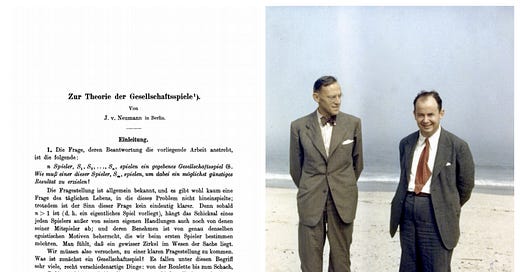
“As far as I can see, there could be no theory of games … without that theorem … I thought there was nothing worth publishing until the Minimax Theorem was proved” — John von Neumann
Hungarian polymath John von Neumann (1903–1957)’s legacy includes significant contributions to the foundations of mathematics and set theory, quantum mechanics and ergodic theory, in addition to early work on computers, nuclear energy and artificial intelligence. Indeed, von Neumann’s output was so considerable in the period from 1925 to the 1950s that to this day, his co-invention of game theory is still only often mentioned as a sidenote.
Make no mistake: Modern game theory began with the idea of mixed-strategy equilibria in two-person zero-sum games, with a proof provided by John von …
Keep reading with a 7-day free trial
Subscribe to Privatdozent to keep reading this post and get 7 days of free access to the full post archives.



